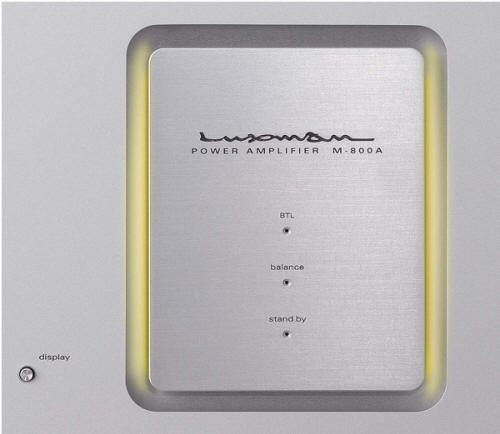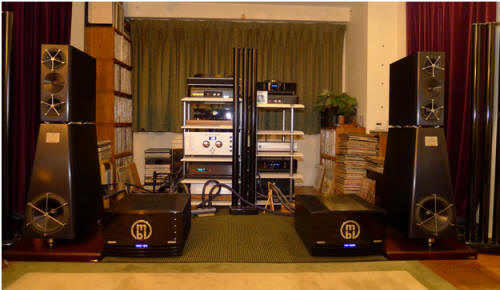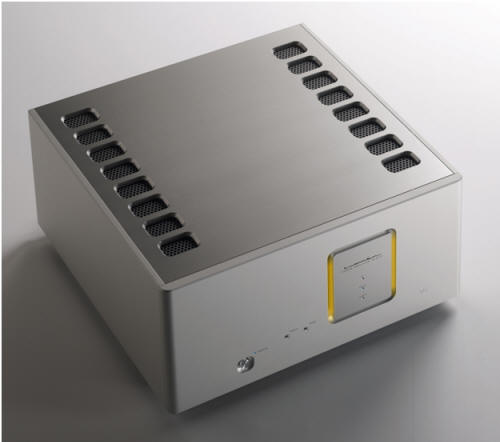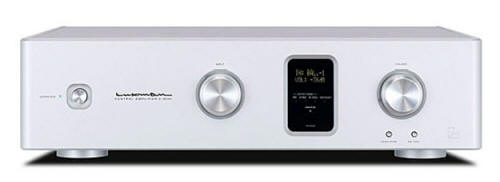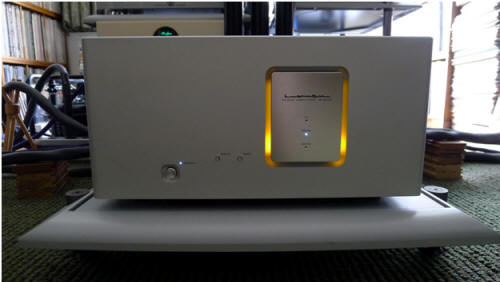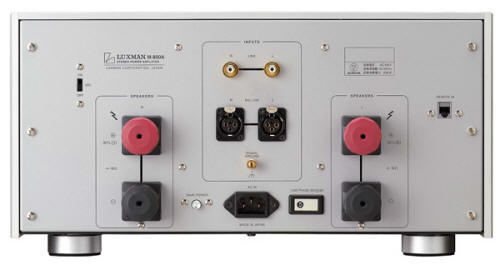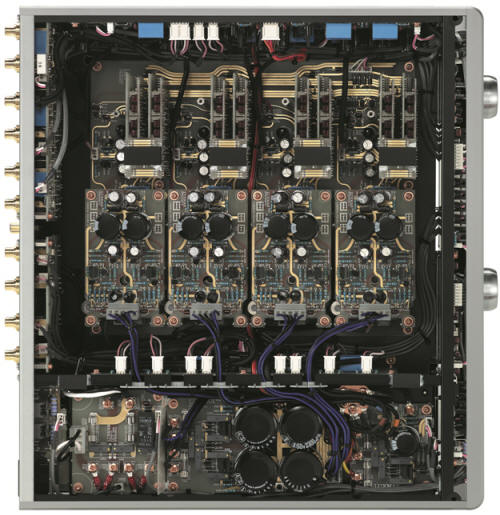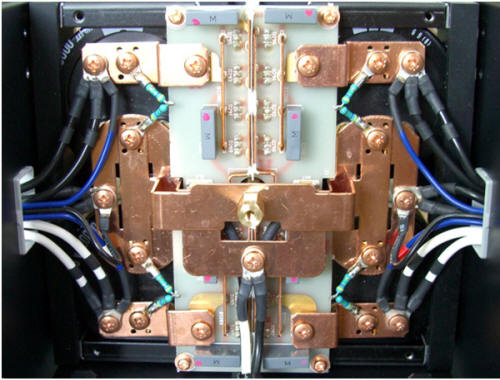|
|
You are reading the older HTML site
Positive Feedback ISSUE 66
luxman M-800A Amplifiers and C-800F Control Amplifier as reviewed by Marshall Nack
"I have an idea of what 60 watts of Class A power will do; I have heard that before. Frankly, I don't see it driving this speaker." Thus spoke Sheldon, my golden-eared panel mate, before we got started. Those were my thoughts exactly during the getting-acquainted period, when I was running a stereo M-800A into my YG Anat Studio speakers, before a second M-800A and the matching C-800f preamp would arrive. (The M-800A can be run in either stereo or mono mode.) Consequently, this review contains sections describing the arrival and installation of the various components in my system. In truth, I was on a roll with amplifiers last year. First I switched from my reference Soulution 710 stereo to the Tenor 175S stereo, a hybrid beauty with 175 watts/channel. Then came the mbl 9008A monoblocks with 440 watts/channel and virtually unlimited headroom. I got used to their megawatts and level of performance—the YG Anats love power. All of these "big boy" amps are in the $55K + territory.
Sure enough, it was immediately obvious that the single M-800A (MSRP $19K) had nowhere near the authority, especially on the bottom, of the mbl 9008A monos it replaced. No surprise, that: the MBL Reference amps own that territory.
So, Sheldon got that right, but the 60 watt Class A, solid-state stereo amp went on to dispel other preconceptions and impress us on four major counts: Control over the speaker drivers. The amp has very good damping capability as observed in the controlled start and stop of the drivers. Driver willfulness is suppressed and the amp is in charge. Macro Dynamic Quality. While dynamic range may not be as wide as the big boys , the quality of macros is excellent. You may notice fall off in sustained tutti passages, but they remain open and distortion free. You'll never hear the amp clip. Signal Purity. I don't hear any grit, grain or other artifact. The M-800A is very pure and direct, without a lot of "stuff" or spin on the signal. Tone is a bit warm and timbre is very satisfying. These are rendered in a tube-like manner, so it is easy to read the signature of each instrument. Resolution. The stereo M-800A offered up a huge amount of detail. Ambient cues are abundant: you'll hear things like slap echo where you hadn't heard them before.
The C-800f Control Amp I happened to have the Fred Hersch Trio's Night and the Music CD (Palmetto, PM 2124) in the tray when I swapped in the Luxman C-800f preamp for the mbl 6010D. This 2007 release was Hersch's first trio recording since the 1990's and it is an exemplary document of the new kind of piano jazz he trail blazed. The pairing of that music and the Luxman preamp was a serendipitous first outing. So relaxed; so unpredictable; and so interesting! Hersch communicates beyond pure technique and is saying something that touches on the spiritual. Note his exquisite pacing. Observe that I didn't say PRAT. In my book, PRAT is about getting your toe in motion and head bopping to a propulsive beat. No, Hersch tends to favor slow rhythms and enjoys lingering over a note and exploring the nuances of a phrase.
So does the C-800f. This kind of observation would be repeated throughout the audition period with varying source material. The C-800f, like the M-800A, is great at extracting and conveying musical meaning. Tone is warm and sweet and timbre is tube-like; different instruments reveal more variation and less sameness.
M-800A Monoblocks By February I put in the second M-800A. Full Luxman amplification was now in place: when I power up the system, the room temperature elevates by about 2 degrees. These Class A monoblocks give off a lot of ambient heat. I put the Fred Hersch Night and the Music CD back in the tray. Now, with the M-800A in mono configuration, the reservations regarding low-end—specifically bass foundation and body needing a tad more flesh—are left by the wayside. Ditto for dynamic range. The M-800A in mono configuration achieves what few amplifiers can: any concerns regarding power recede from our thoughts and the listener's focus moves elsewhere. As the importer's website says, go with monoblocks "…if you need more power & weight to your music. In monaural mode the M-800A delivers 240W into 8Ω," and it's all Class A power. My YG Anat speakers loved 'em! The best quality amplification lends the soundstage firmness and solidity, not wishy-washy vagueness. Images have virtual mass and weight and are planted on terra firma. They don't move about for no reason (like they do when control is lacking). They have support that comes from the ground up. When an instrument speaks, it is intentional—they speak with authority. That description certainly applies to the mbl 9008As. Those amps were champs in this area and remind me of a weightlifter. They throw a muscular, high-mass, firm soundstage. The Luxman monoblocks also throw a muscular and massive soundstage, but it's a bit leaner, because the images are smaller, more compact and taut. They dance around the stage like a graceful gymnast.
Riddle #1 The transient is hard-hitting. Pop! It strikes with a firm punch. But that force is tempered with a soft leading edge—everything is round, nothing is pointed. It is hard and soft at the same time. Riddle #2 Notes tend to linger. The Luxman decay evaporates leisurely, like tubes—the opposite of clipping. (And unlike many solid-state components which have a sharp transient and a foreshortened decay—a nasty combination that makes them sound like an On/Off switch.) The soft onset and leisurely decay may fool you into thinking the amps are slow. Not true. While not as quick as the Soulution 710, it matches the mbl 9008A. The Key to Communication The Luxman preamp and monoblock combination exhibits a virtual panoply of anti-solid-state qualities—that is key to its ability to communicate the musical message. Operating in Class A means it has natural sweetness and warmth. Yes, the gear has a moderate dose of pretty colorations, but they are not overdone. It allows all of the uniqueness in recordings—both the warts and the beauty—to come through. Actually, retrieval of low-level, delicate material is excellent. You can look far and wide—you will not come up with evidence of artifact. Completing the picture, the treble is extended, sweet and never irritating. It will not bite you. The middle is pleasantly full and deeply saturated. The bottom is reasonably well-developed—tight as well as full. Dynamics are consistent over the range, including low-level SPLs, which are rendered as a reciprocal, reduced version of loud. Coherency and integration are superb. Set UP: Power Conditioners, etc I did not get the quality of sound described above until I discovered how sensitive the C-800f was to its environment. The rule of thumb is power amps do not like conditioning. For whatever reason, I found the C-800f preamp is mighty averse to it as well. When used with any power conditioning, passive or active, the C-800f became more rounded, warm and soft—the tubey colorations bloomed. Plug it straight into the wall or use a power strip and you'll get sharper transients and better macros. The C-800f worked excellently with the Soulution 710. However, optimum results were when I paired it with the M-800A amps, which leads me to think you won't really know how good the gear is unless you run all Luxman amplification—plugged straight into the wall, of course.
Cosmetics The Luxman 800 series has contemporary/classic styling. Fit-n-finish is super, as good as it gets. It sports a modern look with smooth, round corners, no exposed screw heads and heat sinks that are hidden inside the chassis. The elegant front panel on the C-800f has minimal controls, but I do wish the display had a larger font—it's too small to read from the listening seat. Instead of power meters, the M-800A has a vertical, yellow band around the Luxman logo on the faceplate that fluctuates in tandem with the musical program, giving you a visual of the power it's putting out. Neat—but if you don't care for the display it can be dimmed or turned off completely. Tech Discussion Luxman invented the application of global negative feedback back in 1955. Though still widely used, they moved on and in the late 1990s took a different approach and invented ODNF (Only Distortion Negative Feedback), where only a small amount of negative feedback is applied to match the level of distortion. Through this means they avoid inducing the phase distortion common to conventional negative feedback systems.
The box within a box chassis construction is composed of mixed layers of steel and aluminum. Inside the M-800A, you'll find solid copper bus bars and gold plating of the copper signal traces. All of the resistors are custom designed and manufactured. (BTW, none of those signal traces turn on right angles. Luxman engineers are fanatical about sound quality, compulsive to an unusual degree. They believe right angles impact sound quality. Consequently, all signal traces make graceful curves on the circuit board.) Binding posts are over-sized plastic knobs that are easily cinched down by hand—no tools are necessary.
One design highlight in the C-800f worth mentioning is that it uses the same volume control developed by Luxman for their statement preamp, the LECUA 1000WM. This very sophisticated device works in the analog domain and has the ergonomic feel of a conventional, high-quality, counterweight movement volume control. However, it doesn't use variable resistors. Consequently, the music signal is not impacted by changes in impedance and there is no deterioration of S/N ratio or frequency response regardless of volume setting.
Both preamp and amp drop the ground leg on the IEC input power cord jacks—ground is floating. When I asked the importer, I was told the components are double-insulated from the ground. Further, many engineers believe this is the right way to approach electrical ground. In my lengthy audition, I was never troubled with ground noise. Conclusion The Luxman 800 series of amplification (the M-800A amp and C-800f preamp) is solid-state, but it can fool you into thinking otherwise, because it doesn't have a solid-state signature. The M-800A amp operates in Class A mode. If that conjures up high purity, you guessed correctly. You'd also be right in thinking grainless, rounded, clear and a bit warm. The midrange is dominant and has high transparency—consequently, micro dynamic vitality gets a boost. This cluster of characteristics, uncommon for solid-state gear, is ideal for communicating the emotional content in the music. But wait! The Luxman 800 series in monoblock configuration also enjoys the benefits associated with the best solid-state gear: dynamics, resolution, and sound-staging. It's high power and Class A all the way. Warm, sweet, detailed and powerful—what a combination for musical pleasure! Highly recommended for jazz and classical aficionados with deep pockets. Marshall Nack
M-800A Amplifier
C-800f Control Amp
Luxman Importer
ON A HIGHER NOTE
|








